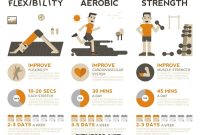Muscle Growth and Strength Gains
Benefits of strength training versus cardio in a gym setting – Strength training, unlike cardio, directly stimulates muscle growth and increases strength. This is achieved through a process called muscle hypertrophy, where muscle fibers are broken down and rebuilt larger and stronger.
Muscle Hypertrophy Effects
Strength training significantly promotes muscle hypertrophy compared to cardio. Cardio improves cardiovascular fitness but has a minimal effect on muscle growth. Strength training creates microscopic tears in muscle fibers, triggering a repair process that leads to increased muscle size and strength.
Mechanisms of Muscle Mass Building
The process begins with the application of resistance that exceeds the muscle’s capacity. This overload causes muscle fiber damage and metabolic stress. The body responds by repairing and rebuilding these fibers, resulting in increased muscle protein synthesis. This process is further enhanced by adequate nutrition and rest.
Progressive Overload in Strength Training
Progressive overload is crucial for continued muscle growth. This principle involves gradually increasing the weight, repetitions, or sets over time to continually challenge the muscles. Without progressive overload, the muscles adapt and growth plateaus. This can be achieved by increasing the weight lifted, increasing the number of repetitions or sets performed, or by decreasing rest periods between sets.
Sample Strength Training Program for Hypertrophy, Benefits of strength training versus cardio in a gym setting

A sample program could involve 3 full-body workouts per week, focusing on compound exercises. Each workout should include 3-4 sets of 8-12 repetitions for each exercise. Rest periods between sets should be 60-90 seconds.
Exercises Maximizing Muscle Growth
Examples of effective exercises include squats (legs and core), bench press (chest, shoulders, triceps), deadlifts (full body), overhead press (shoulders, triceps), and rows (back, biceps).
Bone Density and Strength
Weight-bearing strength training significantly improves bone mineral density, reducing the risk of osteoporosis and fractures. This is because the stress placed on bones during weight training stimulates bone remodeling, making them denser and stronger.
Impact of Strength Training on Bone Mineral Density
Studies have shown that strength training increases bone mineral density in both men and women, particularly in the spine and hip, areas most prone to fractures. This improvement is largely due to the mechanical stress placed on the bones during weight-bearing exercises.
Weight-Bearing Strength Training vs. Cardio on Bone Health
While cardio is beneficial for overall health, weight-bearing strength training is more effective for increasing bone density. Running, for example, is weight-bearing, but the impact is less focused and controlled compared to targeted strength training exercises.
Research Findings on Osteoporosis Prevention
Numerous studies have demonstrated that regular strength training significantly reduces the risk of osteoporosis and related fractures. This is especially important for postmenopausal women, who are at increased risk of bone loss.
Key Exercises Improving Bone Density
Effective exercises include squats, lunges, deadlifts, and overhead presses. These compound movements engage multiple muscle groups and place significant stress on the bones, stimulating bone growth.
Benefits of Strength Training for Bone Health
| Benefit | Description | Mechanism | Example Exercise |
|---|---|---|---|
| Increased Bone Density | Higher bone mineral density, reducing fracture risk. | Mechanical stress stimulates bone remodeling. | Squats |
| Improved Bone Strength | Bones become stronger and more resistant to fractures. | Increased bone mass and improved bone microarchitecture. | Deadlifts |
| Reduced Osteoporosis Risk | Lower risk of developing osteoporosis and related fractures. | Stimulation of osteoblast activity (bone formation). | Lunges |
| Enhanced Balance and Coordination | Improved stability, reducing the risk of falls. | Increased muscle strength supporting joint stability. | Overhead Press |
Metabolism and Calorie Burning
Strength training boosts metabolism both immediately and in the long term, leading to increased calorie expenditure throughout the day. This is primarily due to the increased muscle mass gained through strength training.
Immediate and Long-Term Effects on Resting Metabolic Rate
Strength training increases resting metabolic rate (RMR) more effectively than cardio in the long term. While cardio elevates metabolism during the workout, the effect is temporary. Increased muscle mass from strength training, however, increases RMR even at rest, leading to more calories burned throughout the day.
Muscle Mass and Calorie Expenditure
Muscle tissue is more metabolically active than fat tissue. This means that individuals with more muscle mass burn more calories at rest and during activity compared to those with less muscle mass. A pound of muscle burns more calories than a pound of fat, even when at rest.
High-Intensity Strength Training and Metabolic Impact
High-intensity interval training (HIIT) with strength training can further enhance metabolic benefits. HIIT involves short bursts of intense exercise followed by brief recovery periods. This type of training can significantly increase calorie expenditure during and after the workout.
Role of Post-Exercise Oxygen Consumption (EPOC)
EPOC, or the afterburn effect, refers to the elevated oxygen consumption following exercise. Strength training, particularly high-intensity workouts, results in a greater EPOC than cardio, leading to continued calorie burning even after the workout is complete.
Calorie Expenditure Comparison
| Activity | Duration | Approximate Calories Burned (per 150 lb person) |
|---|---|---|
| Strength Training (moderate intensity) | 30 minutes | 200-300 |
| Cardio (moderate intensity) | 30 minutes | 250-350 |
| Strength Training (high intensity) | 30 minutes | 300-400 |
| Cardio (high intensity) | 30 minutes | 400-500 |
Note: Calorie expenditure varies depending on factors such as intensity, duration, individual metabolism, and body weight.
Cardiovascular Health: Benefits Of Strength Training Versus Cardio In A Gym Setting
Strength training improves several cardiovascular health markers, contributing to overall heart health and reducing the risk of cardiovascular diseases. While cardio is essential, strength training plays a crucial supporting role.
Impact on Cardiovascular Health Markers
Strength training can lower blood pressure and improve cholesterol levels. It also enhances insulin sensitivity, reducing the risk of type 2 diabetes, a significant risk factor for cardiovascular disease.
Improvements in Cardiovascular Fitness
While not as directly impactful as cardio on aerobic capacity, strength training indirectly improves cardiovascular fitness by strengthening the heart muscle and improving blood vessel function. This leads to better blood flow and oxygen delivery to the body.
Contribution to Overall Heart Health
Strength training helps reduce several risk factors for cardiovascular disease, including high blood pressure, high cholesterol, and insulin resistance. This comprehensive approach contributes to overall heart health and longevity.
Research Findings on Cardiovascular Disease Risk Reduction
Studies have shown a correlation between regular strength training and a reduced risk of cardiovascular disease. This is likely due to the combined effects of improved blood pressure, cholesterol levels, and insulin sensitivity.
Combined Strength Training and Cardio Program
A balanced program should include both strength training (2-3 sessions per week) and cardio (3-5 sessions per week). The intensity and duration of each should be adjusted based on individual fitness levels and goals. For example, a program could involve 30-45 minutes of moderate-intensity cardio and 45-60 minutes of strength training per session.
Functional Fitness and Daily Activities

Strength training significantly enhances functional fitness, improving the ability to perform everyday activities with ease and reducing the risk of injuries.
Improved Functional Fitness for Daily Activities
Strength training builds the muscle strength and endurance needed for everyday tasks such as lifting groceries, carrying heavy objects, climbing stairs, and getting up from a chair. These activities require strength and stability, both improved through strength training.
Functional Fitness Improvements: Strength Training vs. Cardio
While cardio improves cardiovascular endurance, strength training directly targets the muscles responsible for performing daily tasks. This targeted approach leads to more noticeable improvements in functional fitness compared to cardio alone.
Strength Training Exercises Enhancing Functional Movement Patterns
Exercises such as squats, lunges, push-ups, and rows mimic everyday movements, strengthening the muscles used in these activities. Deadlifts, in particular, are excellent for improving overall body strength and stability.
Benefits of Strength Training for Injury Prevention
Stronger muscles provide better support for joints, reducing the risk of strains, sprains, and other injuries. Improved balance and coordination also contribute to fall prevention.
Strength Training and Daily Activity Performance
- Lifting Groceries: Stronger back and leg muscles make lifting heavy grocery bags easier and safer.
- Carrying Heavy Objects: Increased strength in the arms and core improves the ability to carry heavy objects without strain.
- Climbing Stairs: Stronger leg muscles make climbing stairs easier and less strenuous.
- Getting Up From a Chair: Stronger leg and core muscles improve balance and make it easier to stand up without assistance.
- Gardening: Increased strength and endurance allow for longer periods of gardening without fatigue or injury.
Mental Health and Well-being
Strength training offers significant mental health benefits, improving mood, reducing stress, and boosting self-esteem. The physical benefits often translate to improved mental well-being.
Impact on Mood, Stress Levels, and Self-Esteem
Strength training releases endorphins, which have mood-boosting effects. The sense of accomplishment and improved physical fitness can also significantly increase self-esteem and reduce stress levels.
Mental Health Benefits: Strength Training vs. Cardio
Both strength training and cardio have positive impacts on mental health, but strength training may offer a stronger boost to self-esteem due to visible physical changes and increased strength.
Role of Endorphins in Improving Mood
Endorphins are natural mood elevators released during exercise. Strength training, especially high-intensity workouts, triggers a significant release of endorphins, contributing to feelings of euphoria and reduced stress.
Strength Training and Positive Body Image
The visible physical changes associated with strength training, such as increased muscle mass and improved physique, can lead to a more positive body image and increased self-confidence.
Feeling of Accomplishment and Improved Self-Confidence
After a challenging strength training session, there’s a profound sense of accomplishment. The feeling of pushing physical limits and achieving strength gains fosters a positive feedback loop, building self-confidence and a sense of empowerment. This feeling extends beyond the gym, positively influencing other aspects of life.



